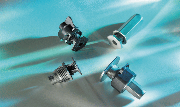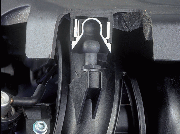 Mechanical fasteners continue to offer cost optimisation opportunities for manufacturers. Andy Witts, managing director of Bollhoff Fastenings, looks at the selection process and some products that are keeping pace with cutting edge design and manufacturing
Mechanical fasteners continue to offer cost optimisation opportunities for manufacturers. Andy Witts, managing director of Bollhoff Fastenings, looks at the selection process and some products that are keeping pace with cutting edge design and manufacturing
Used in a myriad of applications across many industries, fasteners have to deal with different types of stress. Although physical and environmental specifications generally dictate shape and form, some fastener types excel in certain applications. Mechanical fasteners, for example, outperform tapes and adhesives where development of preload is required in a joint.
Ultimately, fastener choice comes down to performance vs. cost effectiveness, and challenges engineers to balance function with integration into manufacturing processes.
With a pedigree stretching back 500 years it is not surprising that mechanical fasteners are historically the first choice solution in automotive and general industrial sectors. Recent innovations utilising the latest engineering design and materials technology, however, deliver cost optimisation benefits that ensure mechanical fasteners continue to step up to the mark.
Tolerance compensation
Bollhoff’s Flexitol stepless tolerance compensation fastener is a good example of how advanced design has been used to engineer a product to meet market requirements for perfect alignment. Comprising two elements – a retainer and a friction bush – the self-adjusting fastener allows the precision alignment of parts simply by installing the original retaining bolt. Not only is manufacturing flexibility increased and costs reduced, but additional savings are made possible by increasing the tolerances on outsourced parts.
In the automotive industry, this fastener is used for headlamp and body panel alignment, trim and cover setting, where fit is critical. Other application areas include the orientation of panels and covers on all types of transport and machinery, visual display units and the tension-free installation of drive units in washing machines.
Push-On-Pull-Off fasteners
Developed to minimise vibration and noise while allowing quick and easy ‘snap-fit’ installation, the Snaploc fastener facilitates repeated disassembly for servicing, repair or replacement, without the need for special tools. In addition, its ball and cup design cuts online assembly operation times and offers further manufacturing savings by reducing the number of parts required.
The product is used to fasten external and internal automotive and motor cycle parts through to power generation plant ducting, removable electrical fittings, consumer electronics panels, medical equipment service access, mechanical handling and machine tool plant covers.
Fastening blind
 One of the most successful fastener technologies used today is Rivtac high speed blind fastening, which has recently been adapted to meet the critical strength and contamination-free assembly requirements of a lightweight solar panel. The main frame requires fixing from one side only, without pre-punching or drilling to avoid compromising structural integrity.
One of the most successful fastener technologies used today is Rivtac high speed blind fastening, which has recently been adapted to meet the critical strength and contamination-free assembly requirements of a lightweight solar panel. The main frame requires fixing from one side only, without pre-punching or drilling to avoid compromising structural integrity.
This solution is particularly suitable for joining aluminium, steel, plastics, mixed materials and multiple-layers.
Arguably Bollhoff’s most well known product in the UK is Rivnut blind rivet nuts and studs. Designed for fastening sheet metal, plastics and even ceramic, these add a load carrying internal or external thread to thin-walled work pieces from one side only in hollow sections, housings or where access is limited.
These are available in steel, stainless steel and aluminium, with different types offering an array of benefits, including optimal torque for high tension requirements, increased ‘pull out’ force and vibration dampening. No additional finishing is required and installation is free of heat, fumes and gasses.
Applications are diverse and include the assembly of automotive and motorcycle bumpers, safety belts, airbags, etc., as well as electrical and electronic products, ovens, extraction hoods, heating and ventilation plant, office and street furniture.
Self piercing rivets
Another widely used fastener is Rivset which provides reliable, high-strength water and airtight fixing without the need for pre-drilling or heat. Suitable for joining metallic and non-metallic materials or dissimilar metals, it can be used with various thicknesses and grades of materials. Successful joints have been produced in aluminium, deep drawing steels, high strength steels and combinations of wood, plastic, copper, films, metal mesh and composite materials.
Applications abound in automotive body-in-white areas as well as in automated road-sign production and the manufacture of heating and ventilation ducts.
Considerations
There are thousands of other types of mechanical fastener available – far too many to cover in this article.
Unless purchasing commodity fasteners, engineers will probably save time and get the best fit if they consult with experts as early as possible in a project. In preparation they should consider end use. What service conditions are to be met – stress, load, shock, temperature etc? Are specific standards to be met? Is service access required? How will the part be assembled, what are the manufacturing processes? Is there an installed cost target?
Bollhoff Fastenings
T: 01902 637161